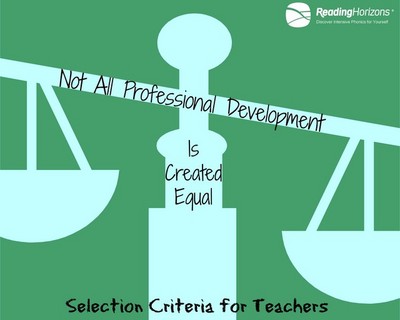
One potential perk of being a teacher is the famed ‘summers off’ phenomenon. Of course, if you ask any teacher what they do in the summer you will inevitably hear about some form of professional development (PD). Those of us who have been around for awhile have spent a fair share of PD time in a required workshop thinking about all of the things that have to be done or feeling that the subject and/or approach is anything but new or not relevant to our setting. Lack of professional development opportunities does not seem to be a problem rather, a lack of high quality professional development opportunities.

In some cases, teachers may not have a choice concerning what kinds of professional development in which they participate, but, if you are a teacher looking for PD that will really make a difference in your teaching and increase student achievement, here are some things to consider:
Which activities are considered ‘professional development’?
Professional Development can take many forms. Along with workshops, conferences, and college classes, professional development can occur through independent reading and research, peer observation, coaching, online courses, and discussions with co-workers.
How much PD time is necessary to see a difference?
More time spent in relevant professional development that focuses on research-based practices equals a more significant change in teacher practices leading to student gains. However, one study of trends in professional development reported that teachers in the U.S. spend more time instructing and less time in professional development than those in top-performing countries (SCOPE & NSDC, 2009-2010).
In its Standards for Staff Development, Learning Forward recommends “that at least 25% of an educator’s work time be devoted to learning and collaboration with colleagues” (NSDC, 2001).
How can you evaluate the effectiveness of professional development?
Researchers have found that professional development has the most impact on student learning when it:
- gives teachers a better understanding of HOW students learn the specified content (Carpenter, 1989)
- strengthens teacher’s content knowledge (McCutchen, 2002)
- teaches effective instructional strategies specifically related to the subject matter (this includes providing materials to be used in the instruction and training on how to use them)
- is closely aligned with actual classroom conditions and standards that teachers are required to teach
- provides measurements to evaluate student progress and success
Just as professional development should take place over time, so should evaluation of professional development. Asking the following questions will help you to evaluate the quality of professional development opportunities.
- Did this professional development opportunity increase my knowledge of the subject?
- Did I learn something that will change (even in a small way) the way I instruct the specified content?
- Do I have proof of improvement in student learning?
- Did I enhance my understanding of how students learn this subject?
- Is the content of the professional development aligned with curriculum standards that are used to guide instruction?
- Is implementation realistically linked to daily classroom experiences?
- Did this professional development opportunity help to increase my ability to monitor student work, provide constructive feedback, and redirect teaching (if necessary) in relation to the specified subject?
How can you identify the best subject matter for professional development?
To identify subject matter for professional development teachers can analyze student data to pinpoint areas of weakness, consider subjects that as a teacher you are less confident teaching, or receive suggestions from an administrator evaluation. You may also want to consider videotaping a lesson or two and watching it to identify areas for improvement (videotaping is also a great way to measure progress). Teachers who have support from colleagues and administrators are more likely to have greater satisfaction and success when applying new knowledge and skills they learned in professional development so, if possible, involve other teachers in this process.
The right type of professional development can make a big difference not only in the progress of students but in job satisfaction for teachers. The wrong type of professional development can leave teachers feeling frustrated and overwhelmed. Advocating for professional development opportunities that will have the greatest impact in the classroom will help to make the most efficient and effective use of your professional development time.



ساحة النقاش